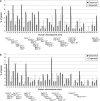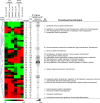Gene signature associated with benign neurofibroma transformation to malignant peripheral nerve sheath tumors
- PMID: 28542306
- PMCID: PMC5443557
- DOI: 10.1371/journal.pone.0178316
Gene signature associated with benign neurofibroma transformation to malignant peripheral nerve sheath tumors
Abstract
Benign neurofibromas, the main phenotypic manifestations of the rare neurological disorder neurofibromatosis type 1, degenerate to malignant tumors associated to poor prognosis in about 10% of patients. Despite efforts in the field of (epi)genomics, the lack of prognostic biomarkers with which to predict disease evolution frustrates the adoption of appropriate early therapeutic measures. To identify potential biomarkers of malignant neurofibroma transformation, we integrated four human experimental studies and one for mouse, using a gene score-based meta-analysis method, from which we obtained a score-ranked signature of 579 genes. Genes with the highest absolute scores were classified as promising disease biomarkers. By grouping genes with similar neurofibromatosis-related profiles, we derived panels of potential biomarkers. The addition of promoter methylation data to gene profiles indicated a panel of genes probably silenced by hypermethylation. To identify possible therapeutic treatments, we used the gene signature to query drug expression databases. Trichostatin A and other histone deacetylase inhibitors, as well as cantharidin and tamoxifen, were retrieved as putative therapeutic means to reverse the aberrant regulation that drives to malignant cell proliferation and metastasis. This in silico prediction corroborated reported experimental results that suggested the inclusion of these compounds in clinical trials. This experimental validation supported the suitability of the meta-analysis method used to integrate several sources of public genomic information, and the reliability of the gene signature associated to the malignant evolution of neurofibromas to generate working hypotheses for prognostic and drug-responsive biomarkers or therapeutic measures, thus showing the potential of this in silico approach for biomarker discovery.
Conflict of interest statement
Figures




Similar articles
-
Molecular profiles of neurofibromatosis type 1-associated plexiform neurofibromas: identification of a gene expression signature of poor prognosis.Clin Cancer Res. 2004 Jun 1;10(11):3763-71. doi: 10.1158/1078-0432.CCR-03-0712. Clin Cancer Res. 2004. PMID: 15173083
-
SOX9 expression increases with malignant potential in tumors from patients with neurofibromatosis 1 and is not correlated to desert hedgehog.Hum Pathol. 2011 Mar;42(3):434-43. doi: 10.1016/j.humpath.2010.02.020. Epub 2010 Dec 28. Hum Pathol. 2011. PMID: 21193222
-
Immunohistochemical analysis of epigenetic factors to differentiate malignant peripheral nerve sheath tumor from benign neurofibroma in a patient with mosaic neurofibromatosis type 1: H3 lysine 27 trimethylation stain and enhancer of zeste homolog 2 stain.J Dermatol. 2018 Nov;45(11):e322-e324. doi: 10.1111/1346-8138.14346. Epub 2018 Apr 23. J Dermatol. 2018. PMID: 29687471 No abstract available.
-
Neurofibroma and schwannoma.Curr Opin Neurol. 2002 Dec;15(6):679-84. doi: 10.1097/01.wco.0000044763.39452.aa. Curr Opin Neurol. 2002. PMID: 12447105 Review.
-
The Challenge of Cancer Genomics in Rare Nervous System Neoplasms: Malignant Peripheral Nerve Sheath Tumors as a Paradigm for Cross-Species Comparative Oncogenomics.Am J Pathol. 2016 Mar;186(3):464-77. doi: 10.1016/j.ajpath.2015.10.023. Epub 2015 Dec 28. Am J Pathol. 2016. PMID: 26740486 Free PMC article. Review.
Cited by
-
Drug Responses in Plexiform Neurofibroma Type I (PNF1) Cell Lines Using High-Throughput Data and Combined Effectiveness and Potency.Cancers (Basel). 2023 Dec 12;15(24):5811. doi: 10.3390/cancers15245811. Cancers (Basel). 2023. PMID: 38136356 Free PMC article.
-
Preclinical Evaluation of Repurposed Antimalarial Artemisinins for the Treatment of Malignant Peripheral Nerve Sheath Tumors.Int J Mol Sci. 2025 Jul 10;26(14):6628. doi: 10.3390/ijms26146628. Int J Mol Sci. 2025. PMID: 40724874 Free PMC article.
References
-
- Sun D, Haddad R, Kraniak JM, Horne SD, Tainsky MA. RAS/MEK-independent gene expression reveals BMP2-related malignant phenotypes in the Nf1-deficient MPNST. Mol Cancer Res. 2013;11: 616–27. doi: 10.1158/1541-7786.MCR-12-0593 - DOI - PubMed
-
- Whelan JT, Hollis SE, Cha DS, Asch AS, Lee MH. Post-transcriptional regulation of the Ras-ERK/MAPK signaling pathway. J Cell Physiol. 2012;227: 1235–41. doi: 10.1002/jcp.22899 - DOI - PubMed
-
- Miller SJ, Jessen WJ, Mehta J, Hardiman A, Sites E, Kaiser S, et al. Integrative genomic analyses of neurofibromatosis tumours identify SOX9 as a biomarker and survival gene. EMBO Mol Med. 2009;1: 236–248. doi: 10.1002/emmm.200900027 - DOI - PMC - PubMed
-
- Evans DG, Baser ME, McGaughran J, Sharif S, Howard E, Moran A. Malignant peripheral nerve sheath tumours in neurofibromatosis 1. J Med Genet. 2002;39: 311–4. Available: http://www.ncbi.nlm.nih.gov/pubmed/12011145 doi: 10.1136/jmg.39.5.311 - DOI - PMC - PubMed
-
- Watson MA, Perry A, Tihan T, Prayson RA, Guha A, Bridge J, et al. Gene expression profiling reveals unique molecular subtypes of Neurofibromatosis Type I-associated and sporadic malignant peripheral nerve sheath tumors. Brain Pathol. 2004;14: 297–303. Available: http://www.ncbi.nlm.nih.gov/pubmed/15446585 - PMC - PubMed
Publication types
MeSH terms
Substances
LinkOut - more resources
Full Text Sources
Other Literature Sources
Research Materials

